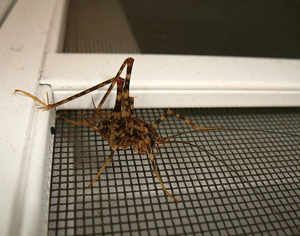The Annual Return of the Camel Crickets
By Chris Williams on August 10, 2013.

Question
Is there anything we can do to prevent those jumping spider crickets that show up about this time every year? We always get them in our yard shed but I can’t stand it when I find them in the basement, too! How come we only get them this time of year?
Answer
I think you’re talking about camel crickets. They have long antennae and very long legs and they jump at the least little disturbance. They’re called camel crickets because they have a high humped back and are camel-colored. They’re sometimes called cave crickets because they are found in caves and other dark, damp places. Unlike other crickets, camel crickets are wingless and a lot of people think they look like spiders.
We don’t notice camel crickets until late summer or early fall simply because that’s when their population is highest and most annoying. They spend all summer growing up from little crickets, so by late August, they’re pretty hard to overlook. They also like to hang out in groups so they are more obvious. When one jumps, they all jump. By fall, they are looking for warmth and start working their way inside. They may also try to change locations if their outside sites get too dry. If you have any kind of openings around your foundation, or under doors (especially garage doors), they will find their way in.
Indoors, they prefer dark, damp areas like garages, basements, and laundry rooms where they feed on organic debris. They don’t bite but they can cause some damage. They can leave dark fecal smears on walls. They sometimes chew on soiled clothing, especially clothing with food stains. The one good thing is that they do not chirp like other crickets. They can be captured with a vacuum or sticky traps.
Seal Camel Crickets Out
Prevent them from getting into your house by pest-proofing or sealing up all of those openings that they can squeeze through. Or, prevention may be as simple as keeping your garage door or basement door closed. Make sure your doors have sweeps or thresholds to eliminate gaps at the bottom. Drying out the damp spaces in your home with fans or a dehumidifier will make the indoor environment much less desirable to crickets. Outdoors, clean up piles of wood, leaves, stones (they’re sometimes called stone crickets, too), and debris that are near your home’s foundation. These provide damp hiding places for crickets. You can also have a pest control company treat around the outside foundation of your home to keep crickets and other insect invaders from getting inside.
Photo credit: Vilseskogen / Foter / CC BY-NC-SA